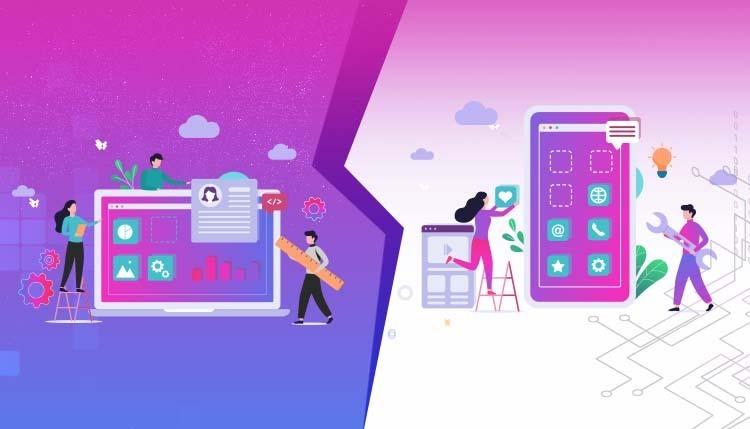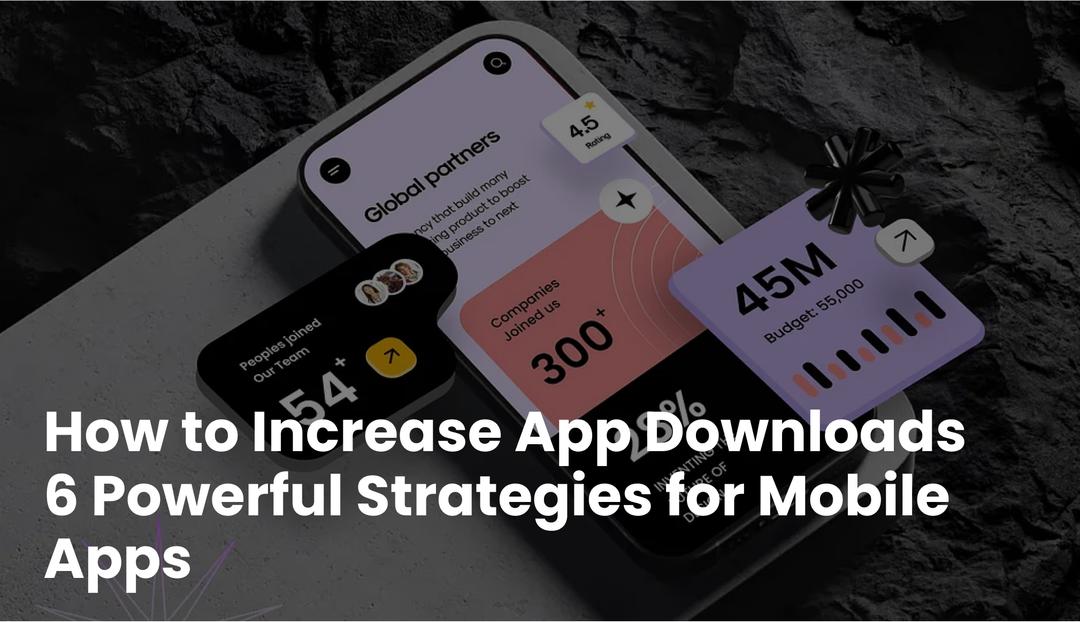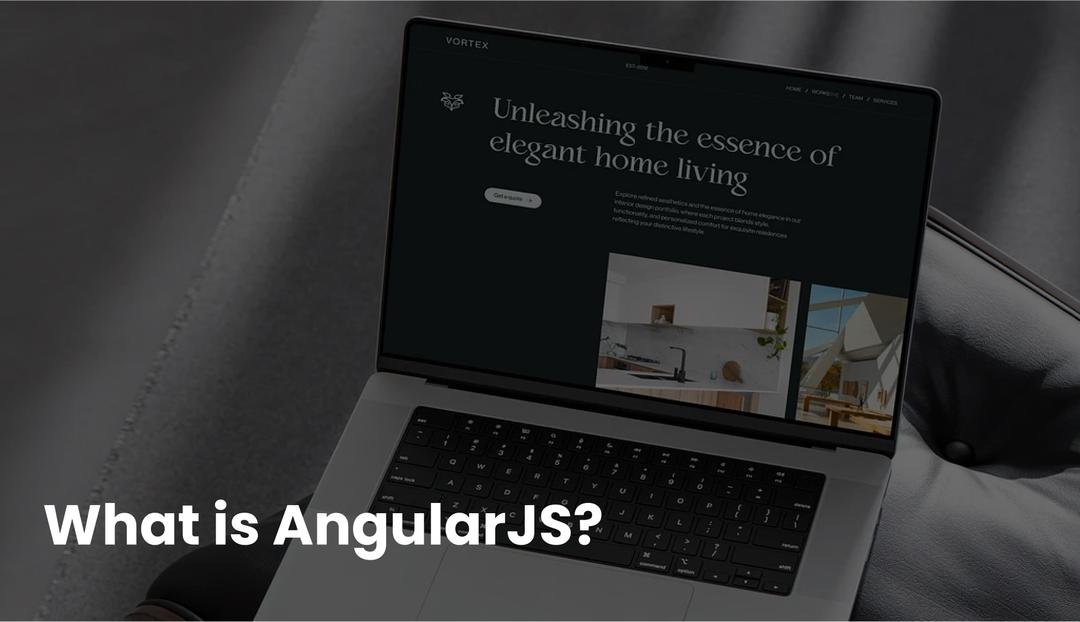But here’s the big question every business faces: Should you go for a web app or a mobile app? Both options can connect you with users, but they come with their own perks and drawbacks, depending on what you’re aiming for, who your audience is, and what your budget looks like.
This guide dives into the key differences between web apps and mobile apps, breaking down essential factors such as development time, cost, technology stack, and user experience to help you make an informed decision.
Whether you’re building a tool for internal use, developing a consumer-facing product, or seeking to expand your digital presence, having a proper understanding of what is crucial.
By the end of this guide, you’ll have a clearer picture of which app is the right fit for your project.
So without further ado, let’s get started!
What is a Web App?
A web app is an application that runs on a web server and is accessed through a browser. Unlike traditional websites, web apps offer dynamic, interactive experiences similar to native mobile apps, but they don’t require installation on a device.
Top 5 Web Apps Examples
- Google Docs – A powerful online document editor that allows real-time collaboration.
- Trello – A project management tool with drag-and-drop functionality.
- Spotify Web Player – A music streaming service accessible directly via browser.
- Canva – An online design tool for creating graphics, presentations, and more.
- Asana – A task management app to track project progress across teams.
Benefits of Web Apps
- No download or installation required.
- Accessible on any device with a browser and internet connection.
- Instant updates (no need for user intervention).
- Single codebase for all platforms (desktops, tablets, smartphones).
Limitations of Web Apps
- Dependent on internet connectivity (though Progressive Web Apps (PWAs) mitigate this).
- Slower performance compared to native mobile apps.
- Limited access to device features (e.g., GPS, camera).
- Lower user engagement due to lack of deep device integration.
What is a Mobile App?
A mobile app is an application specifically designed for mobile devices and installed via app stores like Google Play (Android) or Apple’s App Store (iOS). Mobile apps offer a more immersive, device-optimized experience and can function offline, utilize device hardware, and send push notifications.
Top 5 Examples of Mobile Apps
- Instagram – A photo-sharing app with advanced features like filters, stories, and direct messaging.
- Uber – A ride-hailing app that integrates GPS, payment systems, and live tracking.
- WhatsApp – A messaging app that supports multimedia sharing and end-to-end encryption.
- TikTok – A social media platform for creating and sharing short-form videos.
- Google Maps – A navigation app that offers real-time traffic updates, GPS integration, and offline maps.
Advantages of Mobile Apps
- Fast performance optimized for specific device hardware.
- Can access and utilize device features (e.g., camera, GPS, accelerometer).
- Work offline with local data storage.
- Higher user engagement due to push notifications and home screen presence.
Limitations in Mobile Apps
- Requires installation and regular updates.
- Separate codebases for iOS and Android (unless using cross-platform tools).
- Development and maintenance are more costly.
- Distribution depends on app stores (requires approval and adherence to guidelines).
Key Differences Between Web Apps & Mobile Apps
A mobile app is downloaded and installed from an app store (like Instagram), while a web app runs through a browser (like Google Docs) without needing installation. Mobile apps are often more feature-rich but web apps offer easier access across devices.
| Criteria |
Web App
|
Mobile App
|
|
Platform
|
Accessible via web browsers on any device
|
Native to mobile OS (iOS, Android)
|
|
Internet Access
|
Requires internet (except PWAs)
|
Can work offline
|
|
Performance
|
Dependent on browser, slower
|
Fast, hardware-optimized
|
|
Device Features
|
Limited access (GPS, camera, etc.)
|
Full access to device features
|
|
Updates
|
Instant (server-side updates)
|
Requires user-side updates
|
|
Development Time
|
Quicker, single codebase
|
Longer due to separate builds for iOS/Android
|
|
Development Cost
|
More cost-effective, single codebase
|
Higher due to separate platform builds
|
|
User Engagement
|
Lower (no push notifications)
|
Higher with push notifications and deep UX
|
Which app suits your business best?
Let us help you make the right choice.
Hire Expert
Technology Stack for Web Apps vs Mobile Apps
The technology stack refers to the combination of programming languages, frameworks, and tools used to develop an app. Let’s break down the typical tech stack for both web apps and mobile apps:
Technology Stack for Web Apps
- Frontend (Client-Side): HTML, CSS, JavaScript
- Popular frameworks: React.js, Angular, Vue.js
- Backend (Server-Side): Node.js, Ruby on Rails, Python (Django, Flask), PHP
- Database: MySQL, MongoDB, PostgreSQL
- APIs: REST, GraphQL
- Hosting: AWS, Heroku, Google Cloud, Microsoft Azure
Web apps typically use JavaScript frameworks like React or Angular to build responsive user interfaces. The backend can be built with a range of languages like Python, Node.js, or Ruby, depending on the app’s requirements.
Technology Stack for Mobile Apps
- Native iOS: Swift, Objective-C
- Native Android: Java, Kotlin
- Cross-Platform Tools: Flutter, React Native, Xamarin
- Database: SQLite, Realm, Firebase
- APIs: REST, GraphQL
- Cloud Services: AWS, Google Cloud, Firebase
For mobile apps, the tech stack depends on whether the app is native or cross-platform. Native apps are built with platform-specific languages (Swift for iOS, Kotlin for Android), while cross-platform development tools like Flutter or React Native allow developers to create apps for both platforms using a single codebase.
Confused about the tech stack?
We’ll build your app from start to finish.
Hire Expert
Web App Development vs Mobile App Development
The approach to building a web app slightly differs from building a mobile app. Let’s examine both development approaches:
Development Approach for Web Apps
- Responsive Design: Web apps are designed to work on all devices, from desktops to mobile phones, which requires a responsive design approach.
- Backend Integration: Most web apps rely on APIs to connect the front end to a backend system for data retrieval and storage.
- Browser Compatibility: There’s a strong check on compatibility across different browsers (Chrome, Firefox, Safari) in web app development.
- Development Time: Web app development is generally faster compared to mobile app development, as developers only need to create one version of the app that works across all platforms.
Development Approach for Mobile Apps
- Platform-Specific Design: Mobile apps need to follow the design guidelines of iOS and Android to provide a native feel (e.g., Material Design for Android).
- Native Features Integration: Developers can take full advantage of mobile-specific features like cameras, push notifications, and sensors.
- App Store Submission: After development, the app must be submitted to app stores for approval, which can take time.
- Development Time: Mobile app development takes relatively more time than web app development, especially for native apps, as separate versions need to be built for iOS and Android.
Web App Development vs Mobile App Development Cost
The cost to develop an app can vary significantly depending on its complexity, the features it offers, and the development platform. Here’s a breakdown of the typical costs associated with each:
Web App Development Costs
- Basic Web App: $15,000 – $30,000
- Complex Web App with Backend: $30,000 – $80,000
- Enterprise-Level Web App: $100,000+
Factors influencing web app costs include the number of features, design complexity, integrations, and the hosting infrastructure required.
Mobile App Development Cost
- Basic Mobile App: $20,000 – $50,000 per platform (iOS or Android)
- Feature-Rich App: $50,000 – $120,000 per platform
- Enterprise Mobile App: $150,000+
For mobile apps, the development cost is higher due to the need for separate codebases for iOS and Android, or the use of cross-platform tools, which can still involve significant complexity.
Web Apps vs Mobile Apps – Development Timelines
The time it takes to develop an app is influenced by its complexity, the platform, and the team’s experience. Here’s an estimate for both web and mobile apps:
|
Project Type
|
Web App Development Timeline
|
Mobile App Development Timeline
|
|
Basic App
|
2-4 months: Task manager, simple CMS, basic user authentication
|
3-6 months per platform: Task reminder, note-taking, push notifications
|
|
Moderate Complexity App
|
4-8 months: E-commerce, social networking, third-party integrations
|
6-9 months per platform: Food delivery, social media, in-app payments
|
|
Complex App
|
8-12+ months: SaaS platform, multi-feature, real-time collaboration
|
9-12+ months per platform: Banking, enterprise CRM, biometric security
|
Timeline for Web App Development
Basic Web App (e.g., task manager, simple content management system): 2-4 months
Features include user authentication, basic data storage, and responsive design.
Requires a small team of front-end and back-end developers.
Moderate Complexity Web App (e.g., e-commerce site, social networking app): 4-8 months
Includes integration with third-party services (payment gateways, social logins).
Requires scalability planning and database optimizations.
Complex Web App (e.g., SaaS platform, multi-feature application): 8-12+ months
Advanced functionality such as real-time collaboration, advanced analytics, and third-party API integrations.
Involves larger teams with dedicated DevOps for infrastructure management.
Timeline for Mobile App Development
Basic Mobile App (e.g., task reminder, simple note-taking app): 3-6 months per platform.
Simple interface with limited features like push notifications, local data storage.
Moderate Complexity Mobile App (e.g., food delivery app, social media app): 6-9 months per platform
Includes user profiles, geolocation services, in-app payments, and social sharing features.
Complex Mobile App (e.g., banking app, mobile game, enterprise CRM): 9-12+ months per platform
Features include advanced security measures (biometric authentication), real-time data processing, complex animations, and integration with other apps or devices (e.g., wearables).
The timeline can stretch further depending on how many features you plan to implement at launch, the level of polish, and the number of iterations based on testing feedback.
Need your app developed quickly?
We’ll deliver fast without cutting corners.
Hire Expert
Development Team & Resources Needed
The complexity of your app will dictate the size and skill set of the development team required. Let’s break down the typical team composition for both web and mobile app development projects:
|
Role
|
Web App Development Team
|
Mobile App Development Team
|
| Frontend Developer |
Builds responsive interfaces with HTML, CSS, JavaScript |
Not required for native apps
|
|
Backend Developer
|
Manages server logic, databases, APIs
|
Manages server-side logic for APIs, databases
|
|
UI/UX Designer
|
Designs user-friendly, responsive interfaces
|
Focuses on mobile-specific design and interactions
|
|
QA Tester
|
Tests across browsers for performance and bugs
|
Tests on iOS, Android devices for functionality, bugs
|
|
DevOps/Cloud Engineer
|
Handles server scaling, deployments
|
Manages server scaling for mobile app APIs
|
|
iOS Developer
|
Not required
|
Builds native iOS apps using Swift/Objective-C
|
|
Android Developer
|
Not required
|
Builds native Android apps using Java/Kotlin
|
|
Cross-Platform Developer
|
Not required
|
Optional: Uses React Native/Flutter for cross-platform apps
|
Web App Development Team
- Frontend Developer: Specializes in creating responsive, interactive user interfaces using HTML, CSS, and JavaScript (or frameworks like React.js or Angular).
- Backend Developer: Responsible for server-side logic, database management, and API integration. They work with languages like Node.js, Python, or Ruby.
- UI/UX Designer: Ensures the app is user-friendly, aesthetically pleasing, and responsive across different devices.
- Quality Assurance (QA) Tester: Tests the app across various browsers to ensure consistent performance and bug-free operation.
- DevOps/Cloud Engineer: Manages the hosting environment, server scaling, and automated deployment processes.
Mobile App Development Team
- iOS Developer: Specializes in building native apps for Apple devices using Swift or Objective-C.
- Android Developer: Specializes in building native apps for Android devices using Java or Kotlin.
- Cross-Platform Developer (optional): Uses frameworks like React Native or Flutter to develop apps that work on both iOS and Android.
- Backend Developer: Manages the server-side components (APIs, databases) that power the mobile app.
- UI/UX Designer: Designs the app’s user interface with attention to mobile-specific interactions and gestures.
- QA Tester: Tests the app across different devices (both iOS and Android) to ensure functionality, usability, and performance.
- DevOps/Cloud Engineer: Responsible for backend scaling and deploying server infrastructure for the mobile app’s API.
Other than that, location can also influence development costs.
For instance, if you’re developing a food delivery app in Dubai that often requires advanced functionalities like real-time order tracking, multiple payment gateways, and delivery partner management systems then it may cost you less compared to developing the same app in the US.
Dubai offers a competitive environment due to its tax-free policies and a growing pool of international tech talent, making it a potentially more cost-effective option for businesses.
Looking for the right development team?
Our expert developers are ready to help.
Hire Expert
Maintenance & Updates
Once your app is built and launched, the work isn’t over. Maintenance and updates are necessary to keep it functional, secure, and up-to-date with the latest operating systems and user expectations.
| Feature |
Web App Maintenance
|
Mobile App Maintenance
|
|
Updates
|
Instant server-side updates
|
Users must download updates
|
|
Security
|
Requires frequent security patches for vulnerabilities
|
OS-specific security updates needed
|
|
Compatibility
|
Updates needed for new browser versions
|
Must stay compatible with iOS/Android updates
|
|
User Feedback
|
Immediate fixes via server updates
|
Requires app updates for feedback-based changes
|
|
Store Guidelines
|
No app store compliance required
|
Must comply with app store policies
|
Web App Maintenance
- Routine Updates: Unlike mobile apps, web apps can be updated on the server without requiring users to take action. New features, bug fixes, and performance improvements can be rolled out instantly.
- Security Patches: Web apps are more vulnerable to cyber threats (like XSS and CSRF), so regular security patches are essential to protect user data.
- Compatibility Updates: As new versions of web browsers are released, web apps may need to be updated to remain fully functional on all platforms.
Mobile App Maintenance
- OS Compatibility: With new versions of iOS and Android being released annually, mobile apps need to be updated to stay compatible with the latest operating systems. This might include adjusting for new design guidelines, features, or security protocols.
- User Feedback: User feedback can highlight bugs, performance issues, or feature requests that need to be addressed through updates.
- App Store Guidelines: Apps need to comply with evolving app store policies, and failing to do so can result in the app being removed from the store. This can include updates to privacy requirements, security standards, or general best practices.
Mobile app maintenance typically costs between 15-20% of the initial development cost per year.
User Experience and Engagement: Which Platform is Better?
Both web apps and mobile apps offer seamless user experiences across devices. However, mobile apps have a slightly better chance of delivering an unreal user experience across devices.
Here’s a brief comparison of web apps and mobile apps in terms of user experience:
|
Feature
|
Web App User Experience
|
Mobile App User Experience
|
|
Accessibility
|
Universally accessible across devices and operating systems
|
Designed specifically for mobile platforms
|
|
Responsiveness
|
Requires responsive layouts for different screen sizes, but the experience can vary between devices
|
Native design allows for optimized performance and smoother experience
|
|
Offline Capabilities
|
Limited to online use, but Progressive Web Apps (PWAs) offer some offline access through caching
|
Can work offline by storing data locally, ideal for intermittent connectivity
|
|
Native Performance
|
Dependent on browser and device; may not be as fluid as mobile apps
|
Provides polished, fluid experiences with advanced gestures and animations
|
|
Push Notifications
|
Not generally supported unless using Progressive Web Apps (PWAs)
|
Supports push notifications for user engagement and re-engagement
|
Web App User Experience
- Accessibility: Web apps are universally accessible across devices and operating systems, which makes them great for businesses looking to target a broad audience.
- Responsiveness: A web app must be designed with responsive layouts to adapt to different screen sizes, but the experience can vary between desktop and mobile devices.
- Offline Capabilities: Web apps generally require an internet connection to function fully. However, Progressive Web Apps (PWAs) can offer some offline capabilities by caching data locally.
Mobile App User Experience
- Native Performance: Mobile apps provide a more polished, fluid user experience. Since they are designed specifically for mobile devices, they can utilize advanced gestures, animations, and device features.
- Offline Access: Many mobile apps are designed to work offline or in areas with intermittent connectivity, storing data locally for later synchronization.
- Push Notifications: Mobile apps can send push notifications, which is a powerful tool for engaging users and bringing them back into the app.
Engagement is typically higher with mobile apps, as they allow businesses to interact with users more directly through features like push notifications and access to device hardware. However, web apps excel at offering broader accessibility, especially for users who may not want to install a dedicated app.
Want the best user experience?
We design apps that keep users engaged.
Hire Expert
Web Apps vs Mobile Apps – Monetization Strategies
The monetization strategies for web apps and mobile apps can be totally different. Here’s a brief overview of how entrepreneurs make money from web apps and mobile apps.
Web App Monetization
- Subscription-Based Model: Many web apps (especially SaaS products) use a subscription model, where users pay a recurring fee to access premium features (e.g., Slack, Trello).
- Freemium Model: Offer a free tier with limited features and charge for premium access (e.g., Canva, Spotify Web).
- Advertising: Some web apps generate revenue through display ads or affiliate marketing (e.g., blog platforms, news sites).
Mobile App Monetization
- In-App Purchases: Many mobile apps offer additional content, features, or virtual goods that users can purchase within the app (e.g., games, social apps like TikTok).
- Paid Apps: Users pay a one-time fee to download and use the app (e.g., premium tools, productivity apps).
- Subscription Model: Apps like Spotify and Netflix charge users on a monthly or yearly basis to access premium content.
- Ads: Some free apps display ads within the app to generate revenue (e.g., games, news apps).
Web apps tend to rely more on subscriptions and freemium models, while mobile apps often focus on in-app purchases and ads. The app stores also take a cut from mobile app transactions, typically around 30%, which is something to factor into your monetization strategy.
Key Trends in Web and Mobile Apps
Both web and mobile apps continue to evolve rapidly. Businesses are facing new challenges and opportunities driven by technology trends that are reshaping how apps are developed, delivered, and experienced. Below are five critical trends that will define the future of web and mobile apps moving forward.
Progressive Web Apps (PWAs)
Progressive Web Apps combine the accessibility of web apps with the functionality of mobile apps. They offer features like push notifications, offline access, and smooth navigation, all from a browser—no need for app store downloads. PWAs are built with standard web tech (HTML, CSS, JavaScript), so they work on any device, cutting development costs by avoiding separate apps for iOS and Android.
Why it matters: PWAs deliver app-like experiences without the need for app stores, making them a cost-effective way for businesses to engage users across platforms.
Rise of Cross-Platform Development Tools
Businesses are turning to tools like Flutter, React Native, and Xamarin to build apps for both iOS and Android using a single codebase. This approach reduces development time and costs while offering nearly native performance. Frameworks like Flutter are gaining popularity for their ease of use and robust capabilities.
Why it matters: Cross-platform tools allow businesses to reach more users with less effort, reducing time-to-market and development costs while maintaining high performance.
AI-Powered Personalization
AI is reshaping apps by offering personalized content, product suggestions, and voice-activated features based on user behavior. From AI-driven recommendations to dynamic UIs that adjust in real-time, AI enhances user engagement and satisfaction. Mobile apps are leading this trend, while web apps are catching up with AI-powered chatbots and adaptive layouts.
Why it matters: AI-driven personalization boosts engagement and retention by delivering tailored experiences that make apps more relevant and user-friendly.
Edge Computing for Faster Apps
Edge computing brings data processing closer to the user, reducing latency and improving performance. Apps process data on nearby servers instead of relying on distant data centers, resulting in faster response times—especially in areas with poor connectivity. Web and mobile apps are increasingly using edge computing to provide real-time services like live streaming and gaming.
Why it matters: With reduced latency and faster performance, edge computing is key for apps requiring real-time interactions, making them more responsive and reliable.
API-First Development and Modular Architectures
Apps are increasingly built with modular architectures where components communicate via APIs. This approach allows for independent development and updates without disrupting the entire system. API-first development also enables seamless integration with third-party services like payment gateways and analytics tools.
Why it matters: API-first development ensures apps are scalable, flexible, and easier to maintain, allowing businesses to quickly adapt to new needs and technologies.
Ready to stay ahead of trends?
Let’s build your next-gen app solution.
Hire Expert
Web App vs. Mobile App: Which is Right for Your Business?
As you decide whether to build a web app or mobile app in 2025, the right choice depends on your business goals, audience, and resources. Here’s a quick guide to help you make the best decision:
Why Choose a Web App?
Here’s why a web app might be better aligned your business:
- Cost-effective development: Web apps are typically cheaper to build and maintain, as they run across all devices via browsers.
- Wider audience reach: They can be accessed globally without requiring users to download or install anything.
- Instant updates: You can push updates instantly without needing users to download new versions.
- Ideal for accessibility and fast deployment: Perfect for businesses focused on rapid rollouts and broad accessibility.
Why Choose a Mobile App?
Here’s why a mobile app might be better aligned with your business:
- Superior performance: Mobile apps provide a smoother, faster experience, especially for resource-heavy tasks.
- Deeper device integration: They can access device features like GPS, camera, and biometric sensors more seamlessly.
- Higher user engagement: With push notifications, offline functionality, and better engagement tools, mobile apps excel at keeping users engaged.
- Best for performance and mobile-specific features: Ideal for businesses that need high-performance and mobile-focused capabilities.
Need help deciding between a web or mobile app?
Let us guide you to the best solution.
Hire Expert
Key Takeaways
Choosing between a web app and a mobile app depends on your business goals, audience, budget, and technical needs. Web apps are cheaper, faster to develop, and accessible across platforms, ideal for broad reach. Mobile apps provide a richer user experience, better engagement, and full access to device features, making them great for businesses focused on user retention and performance.
When deciding, weigh factors like cost, timeline, user experience, and monetization. If possible, consider building both to leverage the strengths of each. Understanding their key differences helps you make a choice that aligns with your business and users.
Partner with BitsWits for App Development
Partner with BitsWits for app development to gain expert-driven solutions that deliver results. We’ve been recognized with top industry awards and have helped clients secure funding by building innovative, scalable apps that stand out in the market.
FAQs








